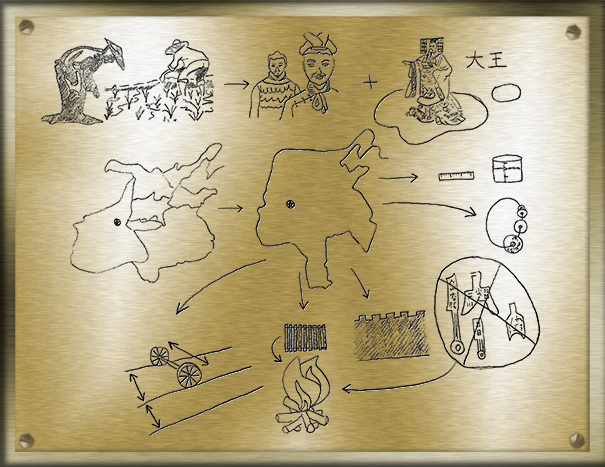| Time Period | Establishment of Qin Dynasty after the Warring States Period |
| Geographical Region | Qin Dynasty territory |
| List of Symbols |
|
In the Warring States Period, China was divided and at war. It was a dangerous place to live. China needed unity and peace. This plaque shows the transition from a divided China to a unified China. The transition brought peace to the land at the cost of lives lost in war, but the benefits of a unified and peaceful China outweighs the cost. Also, this plaque illustrates the new policies brought about by the Qin Dynasty government with symbols indicated by arrows stretching from the map of unified China to the symbols. Some policies helped Qin Shi Huangdi to establish order and uniformity, and others, such as burning of certain books, suppressed dissent in the empire. Although these changes negatively impacted some Chinese, the benefits outweighed the cost—suppression dissent kept China out of civil war, standardization of roads, currency and measurements of length and volume provided uniformity in the empire, and a united China could put up better defense against the northern barbarians.
On the top section of the plaque, rice farmers from the kingdom of Qin are shown to have become foot soldiers that fought to unite China under the Qin. Because they were just farmers drafted into the Qin army, they didn’t have horses, and so they became foot soldiers.
These farmer-foot soldiers of Qin were represented by terracotta statues found in Qin Shi Huangdi’s imperial tomb. The terracotta soldiers in Qin Shi Huangdi’s tomb are placed to the right of the drawings of the rice farmers. The arrow between the rice farmers and the terracotta soldiers means that the farmers became soldiers who fought to unite China.
Qin Shi Huangdi is represented by the line drawing to the right of terracotta soldiers that guarded his tomb. His image has a plus sign to the left such that the plus shows that Qin Shi Huangdi and the terracotta soldiers belong together in their own dynasty. The “di” in his name is translated into “emperor” or “highest deity” according to the Hansen textbook, 2nd edition, thus in my drawing of Qin Shi Huangdi, he is depicted as a deity standing on the cloud. His title emperor in Chinese is to his right. The first Chinese character of his title is “da” (meaning great) and the second Chinese character is “wang” (meaning king). The “wang” character is composed of 3 horizontal lines linked with a vertical line, because the horizontal line represent heaven, people and earth, the vertical line represent the emperor, who rules all three.
Map of the Warring States Period with its Seven Kingdoms. There were only seven kingdoms fighting with each other whereas earlier in history, there were many more warring kingdoms. The arrow pointing to the map to the right shows that the land divided by the 7 kingdoms became unified under the Qin into one empire.
Map of the territory boundary of the newly established Qin Dynasty of the unified China/Empire.
Arrows stretch out from the map of the Qin Dynasty and point to various symbols on the plaque that are representative of the uniqueness of the Qin Dynasty.
The symbol towards the bottom left of the plaque shows that in the Qin Dynasty, the widths of roads and the length of the axle connecting the 2 wheels together were standardized. The double-headed arrows show the standardized length of the axle and the standardized widths of the roads.
The book and the fire symbol show that Qin Shi Huangdi ordered people to burn books, especially Confucian books. These books were bamboo scrolls. Please note that not all books were burnt because some of them survived. So in reality, historical statements that the Qin burnt all the Confucian books are too cut-and-dry to be true.
Qin Shi Huangdi started to build walls that would protect his empire from the Xiongnu of the North (barbarians who wanted invade China). The wall built in the Qin Dynasty was not the Great Wall of China, which was built later. The wall that the Qin built was a lot shorter than the Great Wall, which was lined with bricks. The wall of the Qin Dynasty was built with rammed-earth framed with wooden supports and stone. The significance of the wall of Qin was that it was the first wall in recorded history. They were built to protect China from the northern barbarians, and it inspired the building of the Great Wall of China in the Ming Dynasty.
In the Warring States Period, people used coins shaped into miniature swords or miniature bells to exchange on the market for real swords and bells. But in the Qin Dynasty, these miniature coins were outlawed. These miniature coins were melted down into hot metal, thus my plaque uses an arrow to shows these outlawed miniature coins were put back on fire to be destroyed and melted into hot metal. The coins that were allowed for use in the Qin Dynasty were circular coins that could be stringed together. I have depicted a string of four circular coins on my plaque.
Finally, the Qin standardized measurements of length and volume. My symbols for this are a ruler and a container of water with marked volume.
In conclusion, this plaque shows that Qin Shi Huangdi established a unified China, putting China at peace and the new policies implemented—standardization of roads and axle length, standardization of currency, standardization of measurements of length and volume, burning of books that could cause people to oppose the Qin government, and the building of a wall that protected China from the northern barbarians. The benefits of unifying China and establishing the new policies outweighed the costs. China became unified and peaceful at the cost of deaths of Qin’s enemies. The elimination of currency in the form of miniature objects caused some people to become poorer, but new currency in the form of circular coins facilitated proper trade and monetary exchanges. The standardization of measurements of length and volume as well as road width and axle lengths brought uniformity at the cost needing to modify older vehicles. The burning of Confucian books got rid of potential dissent and allowed Qin to stay in power and to keep China peaceful. The building of the wall protected China at the cost of deaths of laborers building the wall.

JIEYUAN DING is a senior at the University of Rochester (class of 2016). Jieyuan enjoys reading about history, playing the violin, watching movies and watching the news. More by Jieyuan
